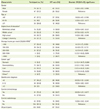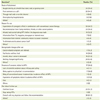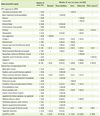1. Ali N, Hussain-Gambles M. Complementary and alternative medicine (CAM) use among South Asian patients with cancer in Britain. Divers Health Soc Care. 2005; 2:41–46.
2. Vickers KA, Jolly KB, Greenfield SM. Herbal medicine: women's views, knowledge and interaction with doctors: a qualitative study. BMC Complement Altern Med. 2006; 6:40.

3. Verhoef MJ, Hilsden RJ, O'Beirne M. Complementary therapies and cancer care: an overview. Patient Educ Couns. 1999; 38:93–100.

4. Cassileth BR, Deng G. Complementary and alternative therapies for cancer. Oncologist. 2004; 9:80–89.

5. Lee E, Shin YC, Lee J, Kim SD, Kim HJ, Jo MS. Use of complementary and alternative medicine in cancer patients at 7 general hospitals in Seoul. J Korean Public Health Assoc. 2002; 28:225–238.
6. Balneaves LG, Kristjanson LJ, Tataryn D. Beyond convention: describing complementary therapy use by women living with breast cancer. Patient Educ Couns. 1999; 38:143–153.

7. Cassileth B, Heitzer M, Gubili J. Integrative oncology: complementary therapies in cancer care. Cancer Chemother Rev. 2008; 3:204–211.

8. Frye RF, Fitzgerald SM, Lagattuta TF, Hruska MW, Egorin MJ. Effect of St John's wort on imatinib mesylate pharmacokinetics. Clin Pharmacol Ther. 2004; 76:323–329.

9. Cassileth B, Yeung KS, Gubili J. Herbs and other botanicals in cancer patient care. Curr Treat Options Oncol. 2008; 9:109–116.

10. Wang S. A research on the actual use of complementary and alternative therapies by cancer patients. Seoul: Kyung Hee University;2007.
11. Moon HW. A study on the use of the complementary and alternative therapy in female cancer patients. Korean J Womens Health. 2004; 5:19–44.
12. Gratus C, Damery S, Wilson S, Warmington S, Routledge P, Grieve R, Steven N, Jones J, Greenfield S. The use of herbal medicines by people with cancer in the UK: a systematic review of the literature. QJM. 2009; 102:831–842.

13. Korea Food & Drug Administration. Health functional food categorized by raw materials. 2009. cited 2012 October 5. Available from
http://www.foodnara.go.kr/hfoodi/.
14. Damery S, Gratus C, Grieve R, Warmington S, Jones J, Routledge P, Greenfield S, Dowswell G, Sherriff J, Wilson S. The use of herbal medicines by people with cancer: a cross-sectional survey. Br J Cancer. 2011; 104:927–933.

15. Kim IK. The use of the functional foods in elderly patients with digestive system cancers. J Korean Gerontol Nurs. 2010; 12:51–61.
16. Song HW. Complementary alternative medicine use of the admitted cancer patients to a general hospital. Health Welf. 2004; 7:37–60.

17. Seol KL, Choi SY, Lee JI. A study on the use, understanding and satisfaction with alternative therapy for hospitalized cancer patients. J Korean Public Health Assoc. 2002; 28:198–211.
18. Kim MJ, Lee SD, Kim DR, Kong YH, Sohn WS, Ki SS, Kim J, Kim YC, Han CJ, Lee JO, Nam HS, Park YH, Kim CH, Yi KH, Lee YY, Jeong SH. Use of complementary and alternative medicine among Korean cancer patients. Korean J Intern Med. 2004; 19:250–256.

19. Qiao YL, Dawsey SM, Kamangar F, Fan JH, Abnet CC, Sun XD, Johnson LL, Gail MH, Dong ZW, Yu B, Mark SD, Taylor PR. Total and cancer mortality after supplementation with vitamins and minerals: follow-up of the Linxian General Population Nutrition Intervention Trial. J Natl Cancer Inst. 2009; 101:507–518.

20. Ministry of Health & Welfare. Cancer facts & figures 2012 in the Republic of Korea. Seoul: Ministry of Health & Welfare;2012.
21. Corner J, Harewood J, Maslin-Prothero S, Lewith G. A study of the use of complementary and alternative therapies among people undergoing cancer treatment: a quantitative and qualitative study. Department of Health NHS R&D programme. London: Department of Health;2006.






 PDF
PDF ePub
ePub Citation
Citation Print
Print



 XML Download
XML Download